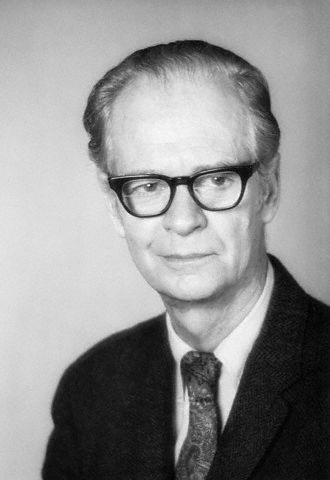B. F. Skinner – Operant Conditioning
Published on June 23rd, 2020
Updated on January 2nd, 2024

Contents
Burrhus Frederic Skinner (B. F. Skinner) was a researcher and psychologist who received his PhD in 1931. Inspired by E.L. Thorndike and John B. Watson, Skinner took a behavioral approach to research in psychology. His research focused on observable behaviors. Such behaviors included thinking, anticipating events, and the method of making decisions.

Skinner believed that human behavior is based heavily on their environment. He also believed that humans most often act in reaction to external stimuli. According to Skinner, human behavior depended on:
Sponsored by

Choose a therapist to work with and start healing with 20% off from BetterHelp.
Click Here- Variables present in a person’s environment.
- The rules or laws of behavior that have been socially established.
B. F. Skinner is most well-known for his theory of operant conditioning. He did recognize both classical conditioning and operant conditioning as relevant in human behavior. However, his research lied heavily on the mechanics of operant conditioning.
Skinner believed that learned behaviors result from operant conditioning. This includes the reinforcement and punishment of behaviors.
Introduction
Operant conditioning is a learning process that influences a person’s behavior. In the concept of operant conditioning, behavior can be modified by reinforcement and punishment. With operant conditioning, it is assumed that behavior is a conscious decision. It is the act of behaving in response to stimuli in the environment.
The theory of operant conditioning reflects on the concepts of the law of effect. The law of effect was developed by E. L. Thorndike, , a fellow psychologist. In the law of effect, Thorndike identifies that behaviors with positive outcomes are more likely to be repeated, and behaviors with negative outcomes are not likely to be repeated.
Skinner used the law of effect to inspire his studies on operant conditioning. Through his research, Skinner discovered that forms of reinforcement will increase the likelihood that a favorable behavior will continue. On the other hand, forms of punishment will reduce the likelihood that an unfavorable behavior will continue.
Skinner’s theory of operant conditioning focuses on punishments and reinforcers as tools to manipulate behaviors. In his theory, he focuses on four main methods of influencers for behavior:
- Positive Punishment
- Negative Punishment
- Positive Reinforcement
- Negative Reinforcement
Punishment
Punishment is reacting to an unfavorable behavior with an unfavorable stimulus. It is intended to not reinforce unfavorable behaviors, making them less likely to happen. Punishments do not extinguish unfavorable behaviors. What they do is make a person less inclined to repeat unfavorable behaviors to avoid unpleasant stimuli in response.
Punishments do not stop unfavorable behaviors from happening. They may repress unwanted behaviors from recurring temporarily, but the behaviors do not typically stay repressed. Eventually, the person will return to the unpleasant behavior. They will likely wait until there is a smaller chance of punishment to re-engage in the unfavorable behavior.
Example: Emily keeps pulling Samantha’s hair. A teacher notices and punishes Emily with a time out. The punishment of a time out does not cause Emily to stop pulling Samantha’s hair. Instead, Emily may wait until a teacher is not around to re-start the hair-pulling behavior.
Skinner agreed with E.L. Thorndike, who believed that punishments alone do not extinguish unwanted behaviors. A combination of punishments and reinforcers is needed to change a behavior. A combination of both will facilitate long-term change in behaviors. This is particularly true in cases of child-rearing.
It is important to note that operant conditioning does not cause a behavior to stop or continue. It does increase or decrease the chances of a given behavior continuing after reward or punishment.
There are two types of punishments in the theory of operant conditioning. The two types of punishments include:
Positive Punishment
Positive punishment refers to the infliction of a negative stimulus in reaction to an unfavorable behavior. This means that something negative is inflicted on a person after they have behaved in an unfavorable way.
The infliction of the punishment decreases the likelihood of the behavior happening again. The affected person may less frequently perform the unfavorable behavior to avoid the punishment in the future. This does not mean that the behavior ceases to happen, but does become less predictable.
Example: Joseph slapped his sister when they got into an argument. As punishment, his father spanked him, which inflicted pain. Joseph has learned that slapping his sister is an unfavorable behavior. This does not mean that he will not do it again, but he does know that slapping his sister may result in a spanking.
Negative Punishment
A negative punishment is the removal of a positive stimulus in response to an unfavorable behavior. In short, a negative punishment is taking something of value away. The removal of an object of value is intended to discourage the unfavorable behavior.
Example: Brianna has been teasing her classmates in school. She knows that teasing is not allowed, but she continues to engage in the teasing behavior. In response to the teasing, Brianna’s teacher takes away her recess time. Brianna is removed from the playground and is forced to sit on a bench for the remainder of recess. Brianna’s teacher used negative punishment by taking away Brianna’s play time during recess. This punishment decreases the chances of Brianna teasing others in the future.
Reinforcement
Reinforcement is defined as a response that encourages favorable behavior. It is a response that increases the chances of a favorable behavior continuing to occur.
Reinforcement strengthens favorable behaviors by rewarding the person who performed the favorable behavior. This strengthens the person’s confidence in the behavior. In return, the confidence increases the chances of the behavior recurring.
Reinforcement is often mistaken for reward. While reward can be a reinforcer, reinforcement and reward are not the same. The difference between reinforcement and reward is as follows:
Reinforcement is an environmental reaction to a person’s behavior that is favorable to the person.
Example: Lisa saw there was ice on her front steps, so she put down salt to make her steps less slippery. She noticed that after she put the salt down, most of the ice melted away. She will likely put down salt again the next time her steps are icy.
Reward is a reaction that is interesting or uplifting. It is given in response for something that the person did that is considered “good. An example would be an accomplishment or successfully following instructions or rules.
Example: Frank mows the lawn and is complimented by how good his yard looks by neighbors. The reward of compliments increases the chances of Frank mowing his lawn regularly.
According to Skinner, there are two main types of reinforcement:
Positive Reinforcement
The term ‘positive reinforcement’ refers to a situation in which a stimulus is added that increases the chances of a behavior repeating itself. This means that a person’s behavior elicits a positive response from the environment. The positive responses makes it more likely for the person to repeat the behavior.
Example: Courtney studied hard for her math quiz. Her parents noticed her behavior and how hard she was working to perform well. As a reward, her parents bought her ice cream. Courtney is more likely to continue to study hard because her behavior was reinforced with a reward of ice cream.
Positive reinforcement does not always include a reward for good behavior. A positive reinforcer can also only elicit a favorable result. The result does not necessarily have to be exciting or rewarding, as long as it is favorable.
Example. Rebecca added fabric softener to her laundry. As a result, her laundry came out of the machine with a fresh scent. Rebecca wants to have the fresh scent in her clothes again, so she will continue to add fabric softener to her laundry.
Negative Reinforcement
Negative reinforcement is the elimination or removal of an unpleasant or unfavorable stimulus. The removal of an unpleasant stimulus increases chances of a behavior continuing to happen in the future. It strengthens the likelihood of the behavior being repeated again.
Example: Rita committed to being responsible with coming home by her curfew each night. For the entire summer, she was never late coming home. Her parents noticed her responsible behavior and decided to reward Rita with lifting the curfew. Rita noted that her responsible behavior resulted in the removal of a restriction, so she will continue to be responsible in the future.
Like positive reinforcement, negative reinforcement also does not have to be accompanied by a reward. It does not need an exciting or stimulating environmental response. As long as the result of the behavior is favorable, it is likely that the person will repeat that behavior again.
Example: Matt sprays mosquito deterrent in his yard. The next day, he notices almost all mosquitos are gone from his yard. Matt is likely to spray mosquito deterrent in his yard again. This is because he observed that the behavior of spraying the deterrent resulted in less mosquitos.
It is important to note that negative reinforcement is not the same as punishment. The two are often confused for each other. Negative reinforcement is something that reinforces favorable behavior. Punishment is something that discourages unfavorable behavior from happening again.
Schedules of Reinforcement
Skinner found reinforcement to be an important part of promoting positive behaviors in people. He noted in his research that in order for reinforcement to be effective, it must have varying degrees of predictability.
Skinner noted that when a subject is conditioned to always expect a reward when completing a behavior, they will stop the behavior when they stop being reinforced with a stimulus. This is why Skinner created the schedules of reinforcement.
The schedules of reinforcement create varying schedules when a subject can expect a reinforcement for favorable behavior. The predictability encouraged the favorable behavior, even though it did not get reinforced every time the behavior was performed.
The 5 main schedules of reinforcement include:
1. Continuous Reinforcement
Continuous reinforcement is a schedule of reinforcement in which a behavior is always reinforced by a stimulus. This means that the behavior can always expect the same stimulus in response.
Example: Henry is hungry. He goes to get something to eat. Once he has eaten, he no longer feels hungry.
Continuous reinforcement does serve its purpose in ensuring self-fulfilling behavior. However, it is not as effective in reinforcing favorable behaviors over unfavorable behaviors.
Example: George, a dog, is given a treat every time he sits when his owner tells him to sit. One day, his owner stops giving him treats every time he sits when he is told. Soon after realizing he will no longer get a treat for sitting, he stops sitting on command.
2. Fixed Ratio Schedule
A fixed ratio schedule is a fixed schedule of reinforcement. This means that the frequency that a behavior is reinforced does not vary. It is a fixed response to a behavior.
Example: Emily has a chore chart. Every time she completes a chore she places a check on her chart. Each time she reaches 10 checks she gets to pick a toy out of a locked toy chest. This is an example of reinforcement because Emily knows each time she completes 10 chores she gets a prize.
Keep in mind that reinforcement does not always need to result in reward. Effective reinforcement follows favorable behaviors with favorable outcomes, even if the outcome is not exciting.
Example: Billy, the family dog, was trained to ring a bell 3 times when he needs to go to the bathroom. Billy knows that once the bell is rung three times someone will open the door. Then, he will be able to go outside to use the bathroom. Knowing this reinforces the behavior of Billy ringing the bell whenever he needs the door open.
3. Variable Ratio Schedule
Similar to fixed ratio reinforcement, variable ratio reinforcement utilizes a ratio schedule of reinforcing favorable behaviors. The difference is, the rate of reinforcement is not fixed. This means that while there is an average of reinforcement per period of favorable behavior, it will not happen at a fixed routine.
For instance, sometimes the behavior will be rewarded after the 3rd repeat of favorable behavior, and sometimes behavior will be rewarded on the 7th time of favorable behavior, and so on. Typically, there is a range of occurrences that the variable ratio schedule follows. This ensures that the schedule remains predictable, but unexpectable depending on the number of times for good behavior.
Example: Miranda goes to the same gumball machine every day after school. She uses the same machine because she knows that sometimes it releases two gumballs instead of one. Miranda knows that she will not get two gumballs every time. She also knows that if she uses this machine, she has an increased chance of getting two gumballs sometimes.
Fixed ratio schedules are often followed by variable ratio schedules. This practice ensures that good behavior continues to be reinforced, but does not make reinforcement a requirement for the continuing of the behavior.
Example: Louis works hard to be a good softball player. His efforts are always reinforced by encouragement and cheers from the crowd. In the first season, Louis’s friend Ben will buy him a soda after every other game. This token of appreciation from Ben reinforces Louis to continue to work hard as a softball player.
In the second softball season, Louis continues to play well. Ben still buys Louis a soda after some games, but not others. Sometimes he will buy after every 2 games, sometimes after 3 games, and sometimes after 4 games. Louis is still reinforced by Ben’s token of appreciation, even though it is not happening every time Louis performs well at a game.
4. Fixed Interval Schedule
A fixed interval schedule is a schedule of reinforcement that is based on time. This means that there is reinforcement scheduled to recur.
Some examples of the schedule for reinforcement could include:
- Every X weeks
- Every X days
- Every X minutes
The fixed schedule encourages behavior. It often encourages behavior that is performed to seek relief.
Example: A person may receive their paycheck of $1000 at 9 am on the 15th of every month. This fixed interval causes that person to check their bank account at 9:15 am on the 15th each month. When they see money in their account, they feel relief. Having money deposited into their account on the 15th of each month at 9 am reinforces the behavior of checking their bank account.
5. Variable Interval Schedule
A variable interval schedule of reinforcement is a schedule of unpredictable incidents of reinforcement. The incidents of reinforcement vary by length of time. Even though the incidents of reinforcement vary by time, the occurrence of reinforcement is consistent. This means the reinforcement can be expected, but predicting when the reinforcing stimulus will occur is not easily done.
Example: Corina is playing peek-a-boo with her baby brother, Daniel. Every time she pops her hands from her face and says ‘peek-a-boo’ her brother laughs. Corina waits until Daniel says ‘knock, knock’ before exclaiming ‘peek-a-boo’.
Daniel knows that when he says ‘knock, knock’, Corina will say ‘peek-a-boo’. He also knows that it may not happen right away. Sometimes Corina will respond immediately. Sometimes she waits 3 seconds, sometimes 7 seconds, etc. Even though Corina waits different lengths of time before responding to his ‘knock, knock’, Daniel knows that she will soon say ‘peek-a-boo’. Daniel stays engaged with Corina for as long as she continues to play the game.
Sponsored by

Find an affordable therapist online with 20% off from BetterHelp.
Click Here






Leave A Reply